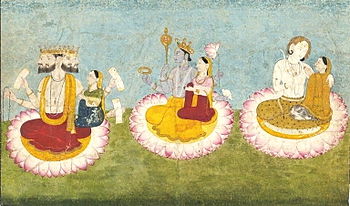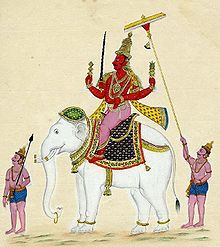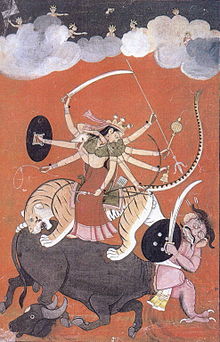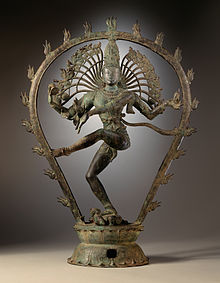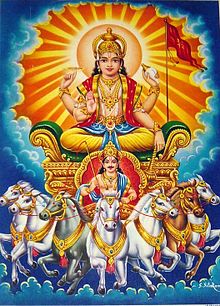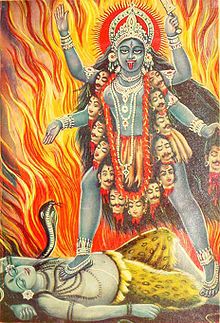- Hindu deities
-
This article is about Deities worshipped as murtis in Hinduism. For the Hindu concept of God, see God in Hinduism.DeitiesPractices
Within Hinduism a large number of personal gods (Ishvaras) are worshipped as murtis. These beings are either aspects of the supreme Brahman, Avatars of the supreme being, or significantly powerful entities known as devas. The exact nature of belief in regards to each deity varies between differing Hindu denominations and philosophies. Often these beings are depicted in humanoid or partially humanoid forms, complete with a set of unique and complex iconography in each case. These deities may be different but they are generally all considered forms of the one god (Brahman). These deities and their Pujas (religious rituals) provide one of the ways to communicate with this one divinity.
The devas are expansions of Brahman into various forms, each with a certain quality. In the Rig Veda 33 devas are described, which are personifications of phenomena in nature.[1]All Hindu deities are composites from the earlier Vedic deities, but this process is not well documented.[2]
Contents
Trimurti and Tridevi
Shiva and Vishnu are regarded as Mahādevas ("great gods" ) due to their central positions in worship and scriptures.[3] These two along with Brahma are considered the Trimurti—the three aspects of the universal supreme God. These three aspects symbolize the entire circle of samsara in Hinduism: Brahma as creator, Vishnu as preserver or protector, and Shiva as destroyer or judge.
The Tridevi or triplet goddesses of Hinduism have close to equal importance as the trimurti. Brahma is creator, so he needs knowledge or goddess Saraswati (Vaak) to create. Vishnu is observer, so he needs the goddess of wealth and prosperity, goddess Lakshmi (Shri). Finally, Shiva is destroyer and re-creator, so he needs goddess Parvati, Durga, or Kali for power. Without the Tridevi, the Trimurti are not complete and vice versa.
Devas and devis
The pantheon in Śrauta consists of many deities. Gods are called devas (or devatās) and goddesses are called devis. The various devas and devis are personifications of different aspects of one and the same God.[4] For instance, when a Hindu thinks of Ishvara as the giver of knowledge and learning, that aspect of Ishvara is personified as the deity Saraswati. In the same manner, the deity Lakshmi personifies Ishvara as the giver of wealth and prosperity.[5] This does not imply that Ishvara is a kind of supreme god or lord of all the other deities; Ishvara is just the name used to refer to God in general, when no particular deity is being referred to. Devas represent certain forces. For instance, Agni has one aspect as the flame, but this flame symbolises the psychological power associated with Agni—namely, the power of will. Agni can be called God-will. Similarly Indra is the God-mind; Sarasvati is the power of inspiration, not merely of learning.[6]
The devas constitute an integral part of the colorful Hindu culture. These various forms of God are depicted in innumerable paintings, statues, murals, and scriptural stories that can be found in temples, homes, businesses, and other places. In Hinduism, the scriptures recommend that for the satisfaction of a particular material desire a person may worship a particular deity.[7] For example, shopkeepers frequently keep a statue or picture of the devi Lakshmi in their shops for financial prosperity. The elephant-headed deva known as Ganesha is worshiped before commencing any important undertaking, as he represents God's aspect as the remover of obstacles. Students and scholars may propitiate Saraswati, the devi of learning, before taking an exam or giving a lecture.
The most ancient Vedic devas included Indra, Agni, Soma, Varuna, Mitra, Savitri, Rudra, Prajapati, Vishnu, Aryaman, and the ashvins. Important devis were Sarasvati, Ushas, and Prithvi. Later scriptures called the Puranas recount traditional stories about each individual deity, such as Ganesha and Hanuman, and avatars such as Rama and Krishna.
Devas in the Vedas
The main devas are (vide 6th anuvaka of Chamakam): Aditya, Agni, Antariksha, Ashwinis, Brahma, Brihaspati, Dishas, Dyaus, Indra, Ganesha, Marutas, Moordha, Prajapati, Prithvi, Pusha, Rudra, Savitr, Shiva, Soma, Varuna, Vayu, Vishnu, and Vishvedavas.
Mother goddesses
Goddesses are worshipped when God is thought of as the Universal Mother, sometimes known as Adi parashakti. Particular forms of the Universal Mother include Lakshmi, Saraswati, Parvati, Durga, and Kali. Shaktism recognizes Shakti as the supreme goddess. The concept of Mahadevi as the supreme goddess emerged in historical religious literature as a term to define the powerful and influential nature of female deities in India. Throughout history, goddesses have been portrayed as the mother of the universe, through whose powers the universe is created and destroyed. The gradual changes in belief through time shape the concept of Mahadevi and express how the different Goddesses, though very different in personality, all carry the power of the universe on their shoulders. Jagaddhatri and Mariamman are other significant female deities.
Avatars as incarnations of God
Many denominations of Hinduism, such as Vaishnavism and some schools of Saivism, teach that occasionally, God comes to Earth as a human being to help humans in their struggle toward enlightenment and salvation (moksha). Such an incarnation of God is called an avatar, or avatāra. In some respects, the Hindu concept of avatar is similar to the belief found in Christianity that God came to the earth incarnated in the form of Jesus. However, whereas most Christians believe that God has assumed a human body only once for a specific purpose, Hinduism teaches that there have been multiple avatars throughout history and that there will be more. Thus the god Krishna, who is not only viewed as an incarnation but also source of all incarnations, says:
Whenever righteousness declines (Yada yada hi dharmasya, glanir bhavati bharata)
And unrighteousness increases, (Abhyuth-thanam adharmasya)
I incarnate myself as a human; (Tadat-manam srijamyaham)
For the deliverance of righteous ones, (Paritranaya sadhunam)
For the annihilation of miscreants, (Vinasaya ca duskrtam)
To reestablish the principles of righteousness (Dharma samsthapanarthaya)
I come into being in every age (Sambhawami yugay yugay) [8] [9]Ten avatars of Vishnu
The most famous of the divine incarnations are Rama, whose life is depicted in the Ramayana, and Krishna, whose life is depicted in the Mahābhārata and the Bhagavata Purana. The Bhagavad Gita, which contains the spiritual teachings of Krishna, is one of the most widely read scriptures in Hinduism.
- Matsya, the fish, appeared in the Satya Yuga. Represents the beginning of life.
- Kurma, the tortoise, appeared in the Satya Yuga. Represents a human embryo just growing tiny legs, with a huge belly.
- Varaha, the boar,appeared in the Satya Yuga. Represents a human embryo which is almost ready. Its features are visible.
- Narasimha, the Man-Lion (Nara = man, simha = lion), appeared in the Satya Yuga. Represents a newborn baby, hairy and cranky, bawling and full of blood.Regarded as the greatest and most powerful avatar.
- Vamana, the Dwarf, appeared in the Treta Yuga. Represents a young child.
- Parashurama, Rama with the axe, appeared in the Treta Yuga. Represents both an angry young man and a grumpy old man simultaneously.
- Rama, Sri Ramachandra, the prince and king of Ayodhya, appeared in the Treta Yuga. Represents a married man with children in a very ideological society. Regarded as the second greatest avatar.
- Krishna (meaning who attracts). This word is used in sense of 'black' also.
- Buddha is Buddha from the Hindu perspective who put forward his knowledge born of sorrowful feelings about the world.
- Kalki ("Eternity", or "time", or "The Destroyer of foulness"), who is expected to appear at the end of Kali Yuga, the time period in which we currently exist, though it has not happened yet. However, over the centuries many sects have believed their spiritual leader to be Kalki. For example, Ismaili Khojas, a Muslim group from Gujarat and Sindh who are followers of Aga khan, believe in the 10 incarnations of Vishnu. According to their tradition Imam Ali, the son-in-law of prophet Muhamad was Kalki.[10][11]
There is also a "hidden avatar" mentioned in 11th canto of the Bhagavata Purana.
Some consider Balarama, brother of Krishna, to be the eighth Avatar of Vishnu. They make Krishna the ninth avatar and delete Buddha. The Buddha avatar, which occurs in different versions in various Puranas, may represent an attempt by orthodox Brahminism to slander the Buddhists by identifying them with the demons.[12] Helmuth von Glasenapp attributed these developments to a Hindu desire to absorb Buddhism in a peaceful manner, both to win Buddhists to Vaishnavism and also to account for the fact that such a significant heresy could exist in India.[13] The Avatars and their stories show that god is indeeed unthinkable,unbelievable and can take any form to protect his people. But other legend states that Balarama was an incarnation of Shesh Naag and hence Buddha is the ninth avatar of Vishnu and Kalki the tenth one who is yet to come at the end of Kaliyuga.
Popular deities
In most Hindu philosophies there is only one ultimate Deity. Also known as Brahman (the infinite manifestation of god within the universe - not to be confused with Atman, the manifestation of god within a body; somewhat comparable to a soul)[14], all others are considered his aspects, or avatars, - Vishnu, the protector or preserver, and Shiva, the destroyer, are the main examples of this, due to them being more popular aspects of the Ultimate Reality. In their personal religious practices, Hindus may worship primarily one or another of these aspects, known as their "Ishta Devata" or "Ishvara"[15] (chosen deity).[16] The particular form of God worshipped as one's chosen ideal is a matter of individual preference,[17] although regional and family traditions can play a large part in influencing this choice.[18] Vaishnavism, Shaivism, Shaktism, and the Ganapatya sects of Hinduism states that Vishnu, Shiva, Devi, and Ganesha respectively equate to Brahman, and that all other deities are aspects of their chosen deity.[19]
Hindus may also take guidance about this choice from scriptures.
Although Hindus do worship deities other than their chosen deity or avatar, of the ultimate reality, from time to time, depending on the occasion and their personal inclinations, it is not expected that they will worship, or even know about, every form that Brahman has taken. Hindus generally choose one concept of Brahman, and cultivate devotion to that chosen form, while at the same time respecting the chosen ideals of other people.[20]
Some popular Hindu deities and avatars include Krishna, Vishnu, Shiva, Durga, Ganesha, Hanuman, Kali, Murugan, Venkateshwara, Nataraja, Rama, Saraswati, and Lakshmi.
330 million gods
It is said that Hindus believe there are 330 million deities. In the Vedas, Thirty-three gods are listed. This is followed by the Sanskrit word koti, which is used for "class"[21] but can also be used for a number equal to 10 million. According to one view, some scholars misinterpreted the word koti - which is meant to mean "class", claiming that there are 330 million gods within Hinduism.[22] Another view contends that 330 million is a figure symbolizing infinity, indicating infinite forms of God.[23][24][25]
Polytheism
Main article: Henotheistic aspects of HinduismThere are some Hindus who consider the various deities not as forms of the one Brahman, but as independently existing entities, and may thus be properly considered polytheists. The quote: "Hindu theology is consistent with monotheism, though it contains seeds of polytheism and idolatry" ~ H. T. Coolebrooke, sums up the general Hindu beliefs about polytheism.[26]
Although the panentheistic tendency in Hinduism allowed only a subordinate rank to the old polytheistic gods, they continued to occupy an important place in the affections of individual Hindus and were still represented as exercising considerable influence on the destinies of man. The most prominent of them were regarded as the appointed "loka palas", or guardians of the world; and as such they were made to preside over the four cardinal and (according to some authorities) the intermediate points of the compass.
Thus Indra, the chief of the devas, was regarded as the regent of the east; Agni, the fire, was in the same way associated with the southeast; Yama, lord of death and justice with the south; Surya, the sun, with the southwest; Varuna, originally the representative of the all-embracing heaven (atmosphere), now the god of the ocean, with the west; Vayu (or Pavana), the wind, with the northwest; Kubera, the god of wealth, with the north; and Soma with the northeast. In some traditions, Ishana—an aspect of Shiva—is regarded as the regent of the northeast and Nirrti the regent of the southwest.
In the institutes of Manu the loka palas are represented as standing in close relation to the ruling king, who is said to be composed of particles of these his tutelary deities. The retinue of Indra consists chiefly of the Devas, gandharvas, a class of genii, considered in the epics as the celestial musicians; and apsaras, lovely nymphs, who are frequently employed by the gods to make the pious devotee desist from carrying his austere practices to an extent that might render him dangerous to their power. Narada, an ancient sage (probably a personification of the cloud, the water-giver), is considered as the messenger between the gods and men, and as having sprung from the forehead of Brahma. The interesting office of the god of love is held by Kamadeva, also called Ananga, the bodyless, because, as the scriptures relate, having once tried by the power of his mischievous arrow to make Siva fall in love with Parvati, whilst he was engaged in devotional practices, the urchin was reduced to ashes by a glance of the angry god. Two other divine figures of some importance are considered as sons of Siva and Parvati, viz. Karttikeya or Skanda, the leader of the heavenly armies, who was supposed to have been fostered by the six Knittikas or Pleiades; and Ganesha (lord of troops), the elephant-headed god of wisdom, and at the same time the leader of the dii minorum gentium.
Denominations of Hinduism
Contemporary Hinduism has four major divisions: Saivism, Shaktism, Smartism, and Vaishnavism.
Hinduism is a very rich and complex religion. Each of its four denominations shares rituals, beliefs, traditions and personal gods with one another, but each sect has a unique philosophy on how to achieve life's ultimate goal (moksa, liberation). For example a person can be a devotee to Shiva and a Vishnu devotee but one can practice the Advaita Vedanta philosophy which believes there is no difference between Brahman and a person's individual soul. Conversely, a Hindu may follow the Dvaita philosophy which stresses that Brahman and the soul are not the same. But each denomination fundamentally believes in different methods of self-realization and in different aspects of the one supreme God. However, each denomination respects and accepts all others, and conflict of any kind is rare.
Vaishnavism, Saivism, and Shaktism, respectively believe in a monotheistic ideal of Vishnu (often as Krishna), Shiva, or Devi; this view does not exclude other personal gods, as they are understood to be aspects of the chosen ideal. For instance, to many devotees of Krishna, Shiva is seen as having sprung from Krishna's creative force. Ganesha worshippers would connect themselves with Shiva as Shiva is the father of Ganesha, making him a Shaiv deity. Often, the monad Brahman is seen as the one source, with all other gods emanating from there. Thus, with all Hindus, there is a strong belief in all paths being true religions that lead to one God or source, whatever one chooses to call the ultimate truth. As the Vedas – the most important Hindu scriptures state: "Truth is one; the wise call it by various names" (transliterated from Sanskrit: Ekam Sat Viprah Bahuda Vadanti.)
Smartism, is monist as well as a monotheist and understands different deities as representing various aspects and principles of one supreme entity, Brahman or parabrahman. Teachers such as Swami Vivekananda, who brought Hinduism to the West, held beliefs like those found in Smartism, although he usually referred to his religion as Vedanta. Other denominations of Hinduism do not strictly hold this belief.
A Smartist would have no problem worshiping Shiva or Vishnu together as he views the different aspects of God as leading to the same One God. It is the Smarta view that dominates the view of Hinduism in the West. By contrast, a Vaishnavite considers Vishnu as the one true God, worthy of worship and other forms as subordinate. See for example, an illustration of the Vaishnavite view of Vishnu as the one true God. Accordingly, many Vaishnavites, for example, believe that only Vishnu can grant moksha.[27] Similarly, many Shaivites also hold similar beliefs for Shiva.
Hindu mythology versus Greek mythology
Similarities between Kama and Cupid, Vishwakarma and Hephaestus and Indra and Zeus do lead many to hastily conclude that Hindu mythology is similar to Greek mythology. But Greek mythology is quite different from Hindu mythology; the two peoples' attitudes to cosmology and the nature of the gods themselves were too different to allow too close a comparison. The Greeks did not believe in only one god – they had gods and goddesses, but no God or Goddess. The gods of Greek mythology became masters of the universe by overthrowing the Titans, an earlier race of powerful beings, who in turn had become powerful by overcoming Giants. Such a theme of repeat succession is missing in Vedic literature. Unlike Greek gods, the Devas (Hindu gods) never feared the Manavas (humans) would overthrow them.[28]
See also
Notes
- ^ Daniélou (1991). pp. 78–84.
- ^ Keay, John (2000). India: A History. New York, USA: Grove Press. p. 147. ISBN 0802137970. http://books.google.com/books?id=3aeQqmcXBhoC.
- ^ Fuller (2004), p. 32.
- ^ Swami Bhaskarananda, (1994), pp. 73–74.
- ^ Swami Bhaskarananda, Essentials of Hindusim 73–74 (Viveka Press 1994) ISBN 1-884852-02-5
- ^ Kashyap, (date unknown).
- ^ ''Bhagavata Purana'' 2.3.1–9. Srimadbhagavatam.com. Retrieved on 2011-06-04.
- ^ Bhagavad Gita, IV 7–8
- ^ Bhagavad Gita As It Is, 4: Transcendental Knowledge, Text 8. Asitis.com. Retrieved on 2011-06-04.
- ^ READING GLOBAL ISLAM THROUGH MESSIANIC RENEWAL IN DASAVATAR – Sikh Formations: Religion, Culture, Theory. Informaworld.com. Retrieved on 2011-06-04.
- ^ Religious Conversion in Shambhala. Berzinarchives.com (2010-07-18). Retrieved on 2011-06-04.
- ^ O'Flaherty, page 200.
- ^ von Glasenapp 1962 page 113, cited in O'Flaherty, page 206.
- ^ Explaining Hindu Dharma (2nd Edition). Vishwa Hindu Parishad (UK). 2002. pp. 14. ISBN 09534354 - 0 - 7.
- ^ Explaining Hindu Dharma (2nd Edition). Vishwa Hindu Parishad (UK). 2002. pp. 14. ISBN 09534354 - 0 - 7.
- ^ Werner (1994), p. 80.
- ^ Harman (2004), p. 106.
- ^ Harman (2004), p. 104.
- ^ "What is Hinduism?: Modern Adventures Into a Profound Global Faith". Himalayan Academy Publications. http://books.google.co.uk/books?id=9XC9bwMMPcwC&pg=PA27&dq=smartism&hl=en&ei=b7OaTojNAcSb8QOj9oThBQ&sa=X&oi=book_result&ct=result&resnum=2&ved=0CDIQ6AEwAQ#v=onepage&q=smartism&f=false. Retrieved 16 October 2011.
- ^ Louis Renou, The Nature of Hinduism 55 (New York 1962)
- ^ Chandra, Lokesh. "Buddhism: Art and values : A collection of research papers and keynote addresses on the evolution of Buddhist art and thought across the lands of Asia". International Academy of Indian Culture and Aditya Prakashan, 2007. http://books.google.co.uk/books?ei=9IKZTpOuGtKy8QPcqZHKBQ&ct=result&id=ICMRAQAAIAAJ&dq=koti+sanskrit&q=koti+sanskrit+33%2C00%2C00%2C000. Retrieved 15 October 2011. ("A popular but unfounded belief has been spread that Hindus have 33 crore (33,00,00,000) gods. It is a misunderstanding of the Vedic concept of the State, and hence a misinterpretation of the word koti. Thirty-three divinities are mentioned in the Yajur-veda, Atharva-... Tibetan masters who translated Sanskrit texts into Tibetan, rendered koti by rnam which means 'class, kind, category'. The thirty-three supreme deities are specified in the Satapatha-brahmana 4.5.7.2 as: 8 Vasus + 11 Rudras + 12 Adityas...")
- ^ Explaining Hindu Dharma (2nd Edition). Vishwa Hindu Parishad (UK). 2002. pp. 14. ISBN 09534354 - 0 - 7.
- ^ Joe David Brown; Time-Life Books (1961), Joe David Brown, ed., India, Time, Inc. "Though the popular figure of 330 million is not the result of an actual count but intended to suggest infinity, the Hindu pantheon in fact contains literally hundreds of different deities [...]"
- ^ Lynn Foulston, Stuart Abbott. Hindu goddesses: beliefs and practices. pp. 1-2. http://books.google.com/books?id=XgwVgPx5G5UC&pg=PA2&dq=%22330+million%22+infinity&hl=en&ei=hheXTpuMNfHb4QSFxpWkBA&sa=X&oi=book_result&ct=result&resnum=2&ved=0CDIQ6AEwAQ#v=onepage&q=%22330%20million%22%20infinity&f=false.
- ^ "Sanskrit: Koti". http://vedabase.net/k/koti. Retrieved 15 October 2011.
- ^ Explaining Hindu Dharma (2nd Edition). Vishwa Hindu Parishad (UK). 2002. pp. 13. ISBN 09534354 - 0 - 7.
- ^ Dvaita Documentation: Vaishnava FAQ. Dvaita.org. Retrieved on 2011-06-04.
- ^ Pattanaik (2009), p. 21.
References
- Vastu-Silpa Kosha,Encyclopadia of Hindu Temple architecture and Vastu/S.K.Ramachandara Rao, Delhi, Devine Books, (Lala Murari Lal Chharia Oriental series) ISBN.978-93-81218-51-8 (Set)
- Daniélou, Alain (1991) [1964]. The myths and gods of India. Inner Traditions, Vermont, USA. ISBN 0892813547.
- Fuller, C. J. The Camphor Flame: Popular Hinduism and Society in India. (Princeton 2004) ISBN 0-691-12048-X.
- Harman, William, "Hindu Devotion". In: Contemporary Hinduism: Ritual, Culture, and Practice, Robin Rinehard, ed. (2004) ISBN 1-57607-905-8.
- Kashyap, R.L. Essentials of Krishna and Shukla Yajurveda; SAKSI, Bangalore, Karnataka ISBN 81-7994-032-2.
- Pattanaik, Devdutt (2009). 7 Secrets from Hindu Calendar Art. Westland, India. ISBN 978-81-89975-67-8.
- Swami Bhaskarananda, (1994). Essentials of Hindusim. (Viveka Press) ISBN 1-884852-02-5.
- Werner, Karel A Popular Dictionary of Hinduism. (Curzon Press 1994) ISBN 0-7007-0279-2.
Further reading
- Chandra, Suresh (1998). Encyclopaedia of Hindu Gods and Goddesses. Sarup & Sons, New Delhi, India. ISBN 8176250392.
- Pattanaik, Devdutt (2003). Indian mythology: tales, symbols, and rituals from the heart of the Subcontinent. Inner Traditions / Bear & Company. ISBN 0892818700.
- Kinsley, David. Hindu Goddesses: Vision of the Divine Feminine in the Hindu Religious Traditions. Motilal Banarsidass, New Delhi, India. ISBN 81-208-0379-5.
External links
- A chart of the main Hindu deities (with pictures)
Hinduism Hindu deities and texts Gods 
Goddesses Texts Categories:
Wikimedia Foundation. 2010.



